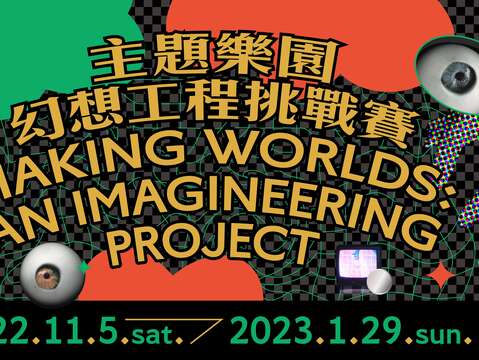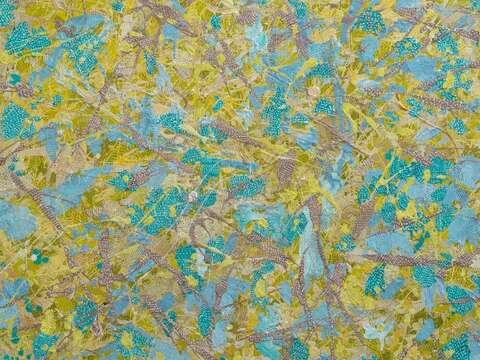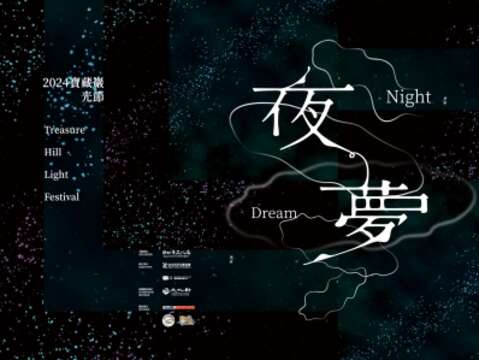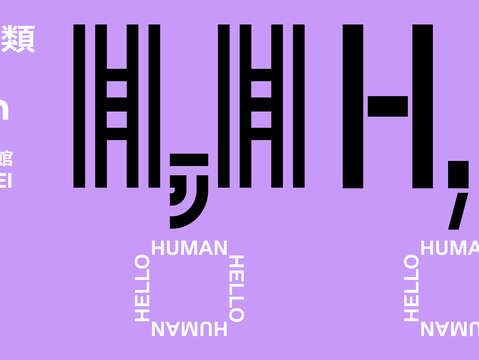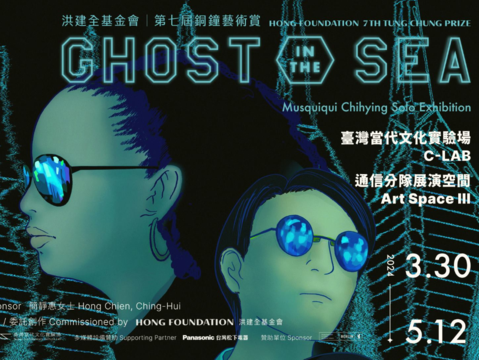Post date:2022-11-14
Updates:2022-11-14
972
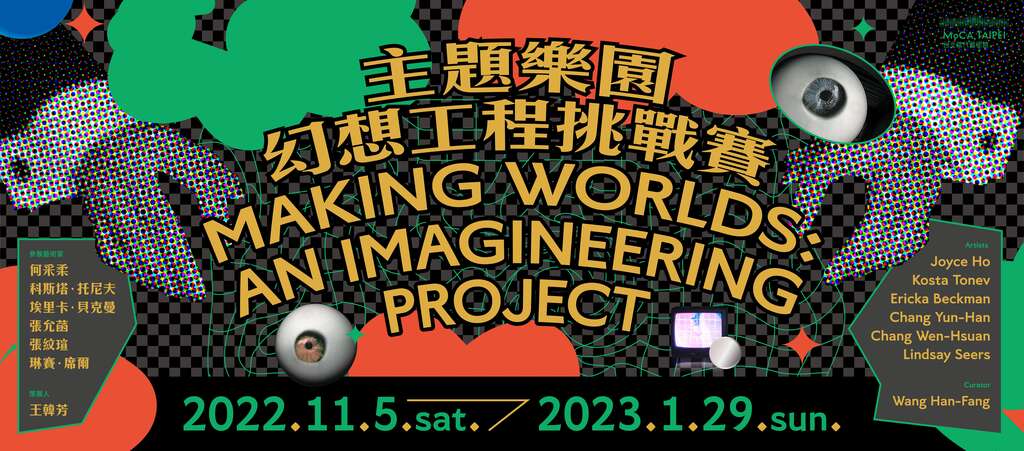
- Event Time
- 2022-11-05~2023-01-29Tue. - Sun. 10:00 - 18:00
- Event Location
- NO.39,Chang-An West Road., Datong Dist., Taipei City Taiwan, R.O.C
In 1955, Walt Disney founded the world’s very first modern theme park Disneyland. A theme park, by definition, is an amusement park where space design, foot traffic flow, mise-en-scènes, audiovisual experiences, characters, and activities all revolve around one, or several, themes or stories. This stylized scenery is the result of a transdisciplinary spatial narrative that serves a particular purpose: conjuring an immersive fantastic environment for each visitor, where, much like a parallel universe, all connections between this land of fantasy and the real world dissolve, and relationships are reconfigured.
The template of theme parks has grown to include myriad versions that cross over to different industries and increasingly expand, riding the waves of globalized replicate culture, ubiquitous digital immersive experience, and the growth of entertainment labor force. Often a highly commercialized and monitored space, a theme park tends to self-replicate and enjoys universal popularity. It comes with theme restaurants, hotels, or shopping malls. It also comes in the form of a historic site or a museum. The careful crafting of a theme park’s atmosphere involves scripted events, visitor experience management, and visitor behavior analysis.
These scripts manifest the ability to decontextualize and recontextualize under different themes, jumping on the bandwagon of post–20th-century narrative, where the focus shifts from temporality to spatiality. Through undertakings from spontaneous arrangement, dislocation, mélange, to reorganization of scenes, these scripts draw inspiration from different cities, spaces, histories, and cultures, enacted with labor in the form of entertainment and performance. These said scripts serve purposes of nostalgia, recreation, ideological campaign, consumerism, or politics, meticulously calibrated to set the designated foot traffic flow, tailor visitor experience, and create anticipated effects, followed by franchise deals executed in other parts of the world, ultimately contributing to the Disneyfication of society. Connections between a themed environment and its locale are not requisite, when a universal adaptability allows the themed environment to blend in any metropolis, simultaneously diluting a city’s function as a place for social interaction. In order to control the atmosphere and foot traffic flow in a themed environment, a security system is often required, with which the management is able to regulate the activities and behaviors of visitors, as well as to prevent visitors from interacting with the external environment. A themed environment adopts gamification strategies, offering rewards to visitors who accomplish tasks. Rewards such as points, achievement badges, and rankings on leaderboards enhance visitors’ participation and value consensus. Nothing and everything exists in a themed environment, where all kinds of pleasant situations provide intense stimulus overload, while in the process of visual symbolization and simplification we confuse make-believe problems and truths in a theme park with real ones of urban life.
Perhaps we can say that a themed environment allows visitors to collectively enter another world of thought constructed by others, allowing us to live various fairytales. Akin less to infrastructure construction than ideology construction, this themed environment substitutes the dreadful and troublesome public domain with the highly regulated, pleasurable domain. This group exhibition pictures the participating artists as imagineers who take on creative engineering projects. The aim is to reveal the system and mechanisms behind engineering, but for the purpose of imagination. Chang Wen-Hsuan reflects on the political operations behind nonverbal narrative techniques, while Lindsay Seers evades linearity by creating elliptical narratives, each riven into an ocean of fortuitous events that interrelate. Kosta Tonev explores the commodification and degeographization of people, events, goods, time, and place in the system, while Ericka Beckman through game mechanics uncovers the system in which society functions and looks for potential breaches. The operations of a theme park, however, still echo the psychological needs and desires of humanity. Chang Yun-Han probes humanity’s eternal longings and dreams for a neverland, while Joyce Ho treads the fine line between the mundane and the human desire for the fantastic, offering a glimpse into the nuanced sensations of the body and mind. Upon entering, the viewer is invited to experience this wonderland and its ceaseless wonders.
The template of theme parks has grown to include myriad versions that cross over to different industries and increasingly expand, riding the waves of globalized replicate culture, ubiquitous digital immersive experience, and the growth of entertainment labor force. Often a highly commercialized and monitored space, a theme park tends to self-replicate and enjoys universal popularity. It comes with theme restaurants, hotels, or shopping malls. It also comes in the form of a historic site or a museum. The careful crafting of a theme park’s atmosphere involves scripted events, visitor experience management, and visitor behavior analysis.
These scripts manifest the ability to decontextualize and recontextualize under different themes, jumping on the bandwagon of post–20th-century narrative, where the focus shifts from temporality to spatiality. Through undertakings from spontaneous arrangement, dislocation, mélange, to reorganization of scenes, these scripts draw inspiration from different cities, spaces, histories, and cultures, enacted with labor in the form of entertainment and performance. These said scripts serve purposes of nostalgia, recreation, ideological campaign, consumerism, or politics, meticulously calibrated to set the designated foot traffic flow, tailor visitor experience, and create anticipated effects, followed by franchise deals executed in other parts of the world, ultimately contributing to the Disneyfication of society. Connections between a themed environment and its locale are not requisite, when a universal adaptability allows the themed environment to blend in any metropolis, simultaneously diluting a city’s function as a place for social interaction. In order to control the atmosphere and foot traffic flow in a themed environment, a security system is often required, with which the management is able to regulate the activities and behaviors of visitors, as well as to prevent visitors from interacting with the external environment. A themed environment adopts gamification strategies, offering rewards to visitors who accomplish tasks. Rewards such as points, achievement badges, and rankings on leaderboards enhance visitors’ participation and value consensus. Nothing and everything exists in a themed environment, where all kinds of pleasant situations provide intense stimulus overload, while in the process of visual symbolization and simplification we confuse make-believe problems and truths in a theme park with real ones of urban life.
Perhaps we can say that a themed environment allows visitors to collectively enter another world of thought constructed by others, allowing us to live various fairytales. Akin less to infrastructure construction than ideology construction, this themed environment substitutes the dreadful and troublesome public domain with the highly regulated, pleasurable domain. This group exhibition pictures the participating artists as imagineers who take on creative engineering projects. The aim is to reveal the system and mechanisms behind engineering, but for the purpose of imagination. Chang Wen-Hsuan reflects on the political operations behind nonverbal narrative techniques, while Lindsay Seers evades linearity by creating elliptical narratives, each riven into an ocean of fortuitous events that interrelate. Kosta Tonev explores the commodification and degeographization of people, events, goods, time, and place in the system, while Ericka Beckman through game mechanics uncovers the system in which society functions and looks for potential breaches. The operations of a theme park, however, still echo the psychological needs and desires of humanity. Chang Yun-Han probes humanity’s eternal longings and dreams for a neverland, while Joyce Ho treads the fine line between the mundane and the human desire for the fantastic, offering a glimpse into the nuanced sensations of the body and mind. Upon entering, the viewer is invited to experience this wonderland and its ceaseless wonders.
 Making Worlds: An Imagineering Project
Making Worlds: An Imagineering Project